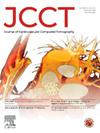CCT-FFR作为有症状的稳定型冠状动脉疾病患者第一策略的临床影响:系统回顾和荟萃分析
IF 5.5
2区 医学
Q1 CARDIAC & CARDIOVASCULAR SYSTEMS
引用次数: 0
摘要
尽管取得了令人鼓舞的结果,但CCT-FFR的临床意义仍存在争议。本荟萃分析旨在确定将FFRCT纳入稳定的CAD管理的潜在益处。在检索了比较疑似稳定型CAD患者在临床判断后接受CCT-FFR作为第一策略与非紧急心血管检查的结果的研究后,我们使用随机效应或固定效应的meta分析模型计算了优势比(ORs)和95%置信区间(ci),这取决于异质性的显著性。定量分析纳入全球5项研究(3项rct和2项观察性研究),共5282例患者(CCT-FFR = 2604例,对照组= 2678例)。总体ICA发生率(OR 1.57, 95%CI 1.36-1.81, p值)本文章由计算机程序翻译,如有差异,请以英文原文为准。

Clinical impact of CCT-FFR as first-strategy in patients with symptomatic stable coronary artery disease: A systematic review and meta-analysis
Aims: Despite the promising results, the clinical implications of the CCT-FFR is already debated. This metanalysis aimed to determine the potential benefits of incorporating FFRCT into stable CAD management.
Methods: After searching for studies comparing outcomes of patients with suspected stable CAD who underwent CCT-FFR as a first strategy versus non-urgent cardiovascular testing after a clinical judgment, we calculated odds ratios (ORs) and 95 % confidence intervals (CIs) using a random-effects or fixed-effects meta-analysis model depending on heterogeneity significance.
Results: 5 studies (3 RCTs and 2 observational studies) globally encompassing 5282 patients (CCT-FFR = 2604 patients, Control Group = 2678 patients) were included in the quantitative analysis. The rates of ICA overall (OR 1.57, 95%CI 1.36–1.81, p value < 0.001) and those without obstructive CAD (OR 6.63, 95%CI 4.79–9.16, p value < 0.001) were reduced in the CCTAFFR group, as compared to the control group. Moreover, CCT-FFR patients underwent coronary revascularization more frequently than patients in the control arm (OR 0.48,CI 0.38–0.62, p value < 0.001). There was no significance difference between the two strategies in terms of 1 year MACE (OR 1.11,CI 0.86–1.44, p value 0.42), nonfatal MI (OR 0.73, CI 0.41–1.33, p value 0.31), all-cause mortality (OR 1.29,CI 0.47–3.54, p value 0.63) and unplanned revascularization for angina (OR 0.99, 95%CI 0.65–1.49, p value 0.95).
Conclusions: In conclusion, in the management of stable CAD, the use of CCT-FFR was associated with lower overall rates of ICA but higher rates of coronary revascularization with comparable 1-year clinical impact.
求助全文
通过发布文献求助,成功后即可免费获取论文全文。
去求助
来源期刊

Journal of Cardiovascular Computed Tomography
CARDIAC & CARDIOVASCULAR SYSTEMS-RADIOLOGY, NUCLEAR MEDICINE & MEDICAL IMAGING
CiteScore
7.50
自引率
14.80%
发文量
212
审稿时长
40 days
期刊介绍:
The Journal of Cardiovascular Computed Tomography is a unique peer-review journal that integrates the entire international cardiovascular CT community including cardiologist and radiologists, from basic to clinical academic researchers, to private practitioners, engineers, allied professionals, industry, and trainees, all of whom are vital and interdependent members of our cardiovascular imaging community across the world. The goal of the journal is to advance the field of cardiovascular CT as the leading cardiovascular CT journal, attracting seminal work in the field with rapid and timely dissemination in electronic and print media.
 求助内容:
求助内容: 应助结果提醒方式:
应助结果提醒方式:


